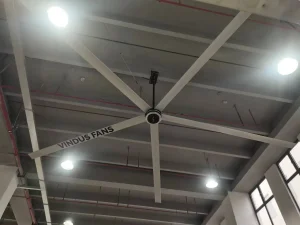Some workplaces feel stifling due to stagnant air and steep energy bills caused by traditional AC systems. This challenge worsens when you rely on inefficient solutions for large spaces. The fix? An HVLS fan—a high-volume, low-speed ceiling fan that elevates airflow, lowers electricity consumption, and boosts comfort.
An HVLS fan (High-Volume, Low-Speed) typically uses less electricity than you’d expect for its size. A larger diameter fan might draw anywhere from 15 watts to over 50 watts, depending on fan specifications like speed setting and motor efficiency. Because these industrial fans operate slowly but circulate a significant amount of air, they can cut cooling costs by up to 30%. In many commercial or industrial settings, the power consumption of an HVLS fan is far lower than running multiple smaller fans or a heavy air conditioner.

HVLS Fans
An HVLS fan is not your average ceiling fan. It’s a large-diameter unit—often spanning up to 24 feet—engineered to circulate massive amounts of air with minimal power consumption. Understanding fan specifications is crucial to determining how much power the system will pull from the grid.
Because HVLS solutions emphasize moving large volumes of air at low speed, these fans often feature specialized, energy-efficient motors that keep electricity usage modest compared to older, high-speed or multi-fan approaches.
Your typical household ceiling fan might use between 15 watts (at a low setting) and 50 watts (on high). It depends on the brand, fan motor capacity, or if there’s a light kit. That’s usually enough for a bedroom or small office, but it might not move nearly enough air in a big warehouse or gym.
By contrast, an HVLS fan—or industrial fans in the same category—cover thousands of square feet using less power than multiple small fans. Although a single HVLS system is physically bigger and uses more electricity than a small ceiling fan, its power consumption per square foot of coverage is typically lower overall.
Example: Let’s say an HVLS unit draws around 200 watt at mid-speed. If that same fan covers 20,000 sq. ft., the cost per square foot for cooling could be more economical than using ten smaller fans at 50 watts each.
HVLS Fans VS other Fans
When we compare an HVLS fan to typical industrial fans, the difference is significant. Traditional industrial fans can come in smaller diameters, often demanding more energy consumption to push comparable airflow. Because an HVLS covers more area at a low speed, it’s more likely to yield energy savings in large, open spaces.
| Feature | HVLS Fan | Standard Industrial Fan |
|---|---|---|
| Diameter | Up to 24 ft or more | Typically 2–4 ft |
| Power Draw | Moderate (often 100–300 W range, varying) | Potentially high if you use multiple units |
| Coverage | Thousands of sq. ft. per fan | Smaller coverage, more fans needed |
| Electricity Consumption | Lower per sq. ft. coverage | Higher per sq. ft., especially with multiple |
The net effect is that while an HVLS might show a higher watt rating on the label, the overall electricity consumption needed to cool the same large area is often less than if you rely on multiple smaller industrial fans. Additionally, HVLS solutions cut down on noise and drafts.
The watt rating on a fan is a direct measure of its potential power consumption. If an HVLS is labeled, for instance, at 200 W, that means at maximum speed it can draw 200 W per hour. Knowing this helps you estimate monthly or yearly usage, especially if the fan will run around the clock in a commercial and industrial setting.
Airflow is measured in cubic feet per minute (CFM) or sometimes cubic meters per hour. The efficiency factor is how many CFMs you get per watt. That ratio reveals how effectively your fan transforms electricity into air movement. HVLS solutions often excel here, delivering a higher ratio than smaller fans because they rely on diameter, blade shape, and slower rotational speeds to move a large amount of air at minimal cost.
Note: “Fan performance depends on matching the type of fan to the environment,” says a specialist in industrial fans. “Selecting the correct fan specifications ensures you get an efficient fan for that space’s shape and occupant load.”
Running a low-speed fan typically leads to lower power consumption. High-speed fans might generate strong breezes but also drive up your electricity bill. By opting for an HVLS solution designed to circulate air gently but over a broad area, you can cut electric usage. This synergy results from aerodynamic blades that move more air for each watt consumed.
Larger diameter fan designs allow a broad sweep, pushing the same or greater volume of air with fewer rotations. This approach is a hallmark of HVLS solutions: They harness slow, wide sweeps to reduce energy usage. That’s why many HVLS fans produce a gentle, consistent cool breeze across an entire facility with less watt load than multiple small, high-speed alternatives.
Case Study: A manufacturing facility replaced 20 high-velocity floor fans with just four HVLS units. Thanks to the HVLS’s slower speed coverage, they saw a 25% drop in energy costs—all while boosting occupant comfort.
A low-speed fan still accomplishes robust air movement by leveraging blade geometry and diameter. HVLS solutions typically incorporate advanced fan motor designs plus specialized blade contours that accelerate and direct airflow effectively. The net effect is a consistent breeze that penetrates large open areas, from warehouses to gyms, making it feel cooler without blasting air conditioner units on full tilt.
HVLS fans represent the pinnacle of energy-efficient mechanical fan technology, reducing electricity consumption while offering consistent, gentle breezes across expansive spaces.
When temperatures drop, hot air collects near the ceiling due to natural convection. HVLS fans can also run in reverse, gently pushing that hot air downward to occupant level. This approach allows you to reduce your heating demands, since you won’t need to keep the heater running as often. In effect, you can warm up the entire space more efficiently.
In warmer months, an HVLS fan can be used alongside a central air conditioner to keep occupant-level temperatures cool. The fans help distribute the chilled air from AC vents, reducing the system’s strain. You might even set your air conditioner a few degrees warmer than normal, reaping significant energy savings. Over an entire season, that can shrink your total energy consumption and prolong the lifespan of your HVAC components.
Testimony: “By layering an HVLS fan’s gentle breeze with the AC, our facility manager states that we saved about 15% on cooling bills and overcame that dreaded mid-summer humidity,” shares an operations director in a distribution center.
When you evaluate fan specifications for an HVLS unit, you’ll want to pay attention to multiple factors, including the motor rating. The type of motor matters greatly for energy efficiency and reliability.
Each variant has different power ratings—some fans can run as low as 50–100 W under normal conditions, while others can climb to 200–300 W at full blast. Make sure to cross-check the “product specifications” section, so you understand how the fan operates at different settings.
Tip: “For large spaces needing year-round airflow, a robust yet efficient fan motor ensures a strong return on investment,” says a commercial facility consultant.
The Right HVLS Fan Motor
When wanting to gauge how much power an HVLS solution or a standard ceiling fan draws monthly, do a brief calculation:
By seeing the above example, it’s clear that even a robust HVLS fan can keep your monthly electricity bill surprisingly low, especially compared to continuous operation of a large-scale air conditioner or multiple smaller fans. Meanwhile, a typical ceiling fan might run at 50 W, but you might need 5–10 such fans to cover the same area an HVLS can handle alone.
Quote: “Calculate how much your HVAC usage might go down once an HVLS is in place, factoring in potential saving on the AC side,” suggests an energy auditor.
How does the size of the fan affect power consumption?
Generally, a larger diameter fan can move more air at low speed, thus lowering the overall watt draw for big spaces. While physically bigger fans can have higher maximum wattage, their coverage area is so broad that the net energy usage per square foot remains modest.
Do HVLS fans operate at higher speed if the temperature gets very hot?
Yes, many HVLS systems come with variable speed control. This means you can ramp up fan performance on scorching days for additional cooling. However, even at a higher speed, HVLS fans remain comparatively efficient, especially when you consider the massive coverage.
Does a fan can also help with heating?
Absolutely. HVLS solutions also run in reverse, pushing hot air down from the ceiling in winter. This technique, known as destratification, reduces your reliance on heating systems and can lower utility bills.
Can HVLS fans replace an air conditioner entirely?
In extremely hot climates, you might still need AC for maximum cooling. However, HVLS drastically complements or supplements AC, helping you set the thermostat higher while maintaining comfort. This synergy can lead to substantial energy savings.
What about the electricity usage of smaller fans vs. HVLS fans?
While smaller fans might use fewer watts individually, you usually need multiple units to cover large spaces, which can collectively consume more power. One HVLS system can replace many small units, meaning less total power consumption.
To wrap up: How much power does a HVLS fan use? The answer is surprisingly little for the airflow you get—somewhere in the realm of 50–300 watts at typical operating speeds, though exact numbers depend on fan specifications, motor type, and speed settings. Because an HVLS fan can circulate vast amounts of air in a large facility, it slashes the total number of smaller units needed to achieve the same cooling effect. That yields direct energy savings—and that’s on top of intangible benefits like better occupant comfort, improved air movement, and more consistent heating and cooling synergy.
At our hvls fans Manufacturing business, we strive to produce solutions that optimize performance while minimizing electricity consumption. Our commitment to delivering energy-efficient results means you get a fan that not only meets the square footage demands of your building but also helps trim your monthly power bills. Whether you operate a massive warehouse, a bustling gym, a tech-savvy school, or a factory in need of more air circulation, an HVLS approach can be your next best step.
Remember: By adopting HVLS solutions, you ensure a cool breeze in summer, effective heat distribution in winter, and an overall improvement to occupant well-being. With the right fan installed, you’ll reduce overhead costs and keep your facility humming with productivity—all while using less electricity.
By harnessing the fan specifications that suit your space, you can drastically reduce your energy consumption and keep your employees or patrons cool. HVLS fans remain a standout choice for modern, cost-conscious facility managers looking to lowering the cost of climate control. If you need more insights on how an HVLS solution might mesh with your environment, feel free to contact us at our hvls fans Manufacturing center. Our aim: to help you lock in comfort, energy efficiency, and reliability—no matter the size or complexity of your space.

Hi, I’m Michael Danielsson, CEO of Vindus Fans, with over 15 years of experience in the engineering and design industry. I’m here to share what I’ve learned. If you have any questions, feel free to contact me at any time. Let’s grow together!